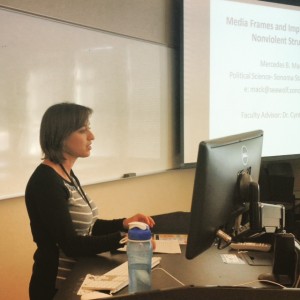Photos: Professor Boaz and me; me presenting at the conference
I have been learning under Metta Center board member Professor Cynthia Boaz since December 2014, working on research about the implications of media frames on nonviolent struggle—specifically the ongoing nonviolent struggles against occupation in Palestine.
This past week, I presented my findings to faculty and students from all over the country in Spokane, WA, at the National Conference for Undergraduate Research (NCUR 2015). I was the only student from Sonoma State University—and the only presenter discussing civil resistance.
 Our research analyzed media frames, specifically the use of metaphor, in reports of the Palestinian nonviolent struggle (2003–2010), and compared the results to metaphors used in reporting during the Green Revolution in Iran (2009).
Our research analyzed media frames, specifically the use of metaphor, in reports of the Palestinian nonviolent struggle (2003–2010), and compared the results to metaphors used in reporting during the Green Revolution in Iran (2009).
The effect of media frames on nonviolent struggle is important to analyze because of the possible implications framing has on how casual media consumers understand nonviolent struggle and how events are contextualized within the larger conflict.
At the most basic level, mainstream media set the news agenda simply by what they choose to report; the choice of media frames used shapes readers’ opinions about what is reported. In the case of Palestine, nonviolent struggle is almost always left out of the frame altogether and when it is reported, it is without context and described with metaphors that reinforce existing misconceptions about Palestinians.
So far, in a basic analysis of 100 articles, we found that Palestine/Palestinians were mentioned less than Israel/Israelis, even in articles in which Palestine was the main subject. The differentiation between Palestinian protestors and Hamas was not clear and 90% of the time, Israel is portrayed using strong militaristic language. Any reference to nonviolence specifically only occurred at a rate of 3%.  What I hope to do in the future is establish an empirical method to evaluate the relationship between U.S. foreign policy and media reporting of nonviolent struggle. Do domestic media report nonviolent struggle only in situations that align with U.S. foreign policy? If so, what are the implications of this dangerous bias? How does misrepresentation or complete omission from the media narrative affect the nonviolent struggle itself?
What I hope to do in the future is establish an empirical method to evaluate the relationship between U.S. foreign policy and media reporting of nonviolent struggle. Do domestic media report nonviolent struggle only in situations that align with U.S. foreign policy? If so, what are the implications of this dangerous bias? How does misrepresentation or complete omission from the media narrative affect the nonviolent struggle itself?
I’m happy to say my presentation was well attended. I was pleased to hear that several students specifically came because I was talking about nonviolent struggle. Both Professor Boaz and I made connections with amazing students and faculty, exchanged resources, and had fruitful discussions. It was empowering to have the opportunity to discuss nonviolence in an academic setting and apply knowledge from all my wonderful mentors at Metta Center. As I was presenting, I had a realization: I am contributing to a peaceful future! By sharing what I’ve learned about nonviolence (which I know many of the students in attendance learned about just by chance of being there), I am spreading peace!
I encourage you to do the same—to recognize where you spread peace and continue to be a satyagrahi in whatever capacity you can. Be actively against injustice, but be actively for peace.









Thanks for this write-up, Mercedes, and thanks to Metta for posting it. It was a pleasure to work with you on this project, and I think you encapsulated the significance perfectly.